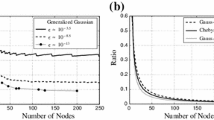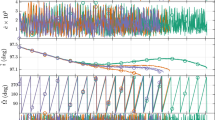Abstract
The Gauss-Jackson multi-step predictor-corrector method is widely used in numerical integration problems for astrodynamics and dynamical astronomy. The U.S. space surveillance centers have used an eighth-order Gauss-Jackson algorithm since the 1960s. In this paper, we explain the algorithm including a derivation from first principals and its relation to other multi-step integration methods. We also study its applicability to satellite orbits including its accuracy and stability.
Similar content being viewed by others
References
JACKSON, J. “Note on the Numerical Integration of d2x/dt2 = f(x, t),” Monthly Notes, Volume 84, Royal Astronomy Society, 1924, pp. 602–606.
KOSKELA, P.E. “Astrodynamic Analysis for the Advanced Orbit/Ephemeris Subsystem,” Technical Report U-4180, Philco-Ford Corporation, Aeronutronic Division, Newport Beach, California, September 1967.
NEAL, H. L., COFFEY, S. L., and KNOWLES, S. “Maintaining the Space Object Catalog with Special Perturbations,” in F. Hoots, B. Kaufman, P. Cefola, and D. Spencer, editors, Astrodynamics 1997 Part II, Volume 97 of Advances in the Astronautical Sciences, pp. 1349–1360.
CASALI, S. “Conjunction Analysis Approach for the Astrodynamics Support Workstation (ASW),” presented at the Core Technologies for Space Systems Conference, Colorado Springs, Colorado, November 19–21, 2002.
MAURY, J. L. and SEGAL, G. P. “Cowell Type Numerical Integration as Applied to Satellite Orbit Computation,” Technical Report X-553-69-46, NASA, 1969, NTIS #N6926703.
NORAD “Mathematical Foundation for SCC Astrodynamic Theory,” Technical Report TP SCC 008, Headquarters North American Aerospace Defense Command, 1982. Obtainable from Defense Technical Information Center, Cameron Station, Alexandria, VA 22304-6145, as AD #B081394.
WOODBURN, J. “Mitigation of the Effects of Eclipse Boundary Crossings on the Numerical Integration of Orbit Trajectories Using an Encke Type Correction Algorithm,” presented as paper AAS 01-223 at the AAS/AIAA Space Flight Mechanics Meeting, Santa Barbara, CA, February 11–14, 2001.
BERRY, M. and HEALY, L. “The Generalized Sundman Transformation for Propagation of High-Eccentricity Elliptical Orbits,” Advances in Astronautics, San Diego, CA, February 2002.
BERRY, M.M. A Variable-Step Double-Integration Multi-Step Integrator, Ph.D. thesis, Virginia Polytechnic Institute and State University, Blacksburg, Virginia, April 2004. Available at permanent link http://scholar.lib.vt.edu/theses/available/etd-04282004-071227/.
HERRICK, S. Astrodynamics: Orbit Correction, Perturbation Theory, Integration, Volume 2, Van Nostrand Reinhold Company, New York, 1972.
FRANKENA, J.F. “Störmer-Cowell: Straight, Summed and Split. An Overview,” Journal of Computational and Applied Mathematics, 62: 129–154, 1995.
WALLNER, R. N. “Earth Gravitational Error Budget Initial Report,” Technical report, Kaman Sciences Corporation, 1500 Garden of the Gods Road, Colorado Springs, CO 80907, November 1994, System Memorandum KSPACE 95–18.
HENRICI, P. Discrete Variable Methods in Ordinary Differential Equations, John Wiley and Sons, New York, 1962.
VALLADO, D. A. Fundamentals of Astrodynamics and Applications, Volume 12 of The Space Technology Library, Microcosm Press and Kluwer Academic Publishers, El Segundo, California and Dordrecht, The Netherlands, second edition, 2001.
MONTENBRUCK, O. and GILL, E. Satellite Orbits, Springer, New York, 2000.
DAVIS, P. J. Interpolation and Approximation, Dover, New York, 1975.
National Imaging and Mapping Agency “Department of Defense World Geodetic System 1984, its Definition and Relationships with Local Geodetic Systems,” Technical report, National Imaging and Mapping Agency, 1997. Available at permanent link http://earth-info.nga.mil/GandG/tr8350_2.html. This publication covers changes made to the standard since 1984 which are not incorporated into this software.
JACCHIA, L. G. “New Static Models of the Thermosphere and Exosphere with Empirical Temperature Models,” Technical Report 313, Smithsonian Astrophysical Observatory, 1970.
MERSON, R. H. “Numerical Integration of the Differential Equations of Celestial Mechanics,” Technical Report TR 74184, Royal Aircraft Establishment, Farnborough, Hants, UK, January 1975, Defense Technical Information Center number AD B004645.
Author information
Authors and Affiliations
Corresponding author
Additional information
Based on paper AAS 01-426 presented at the AAS/AIAA Astrodynamics Specialists Conference, Quebec City, Canada, July 30–August 2, 2001.
This work was completed while the first author was a Graduate Assistant in the Department of Aerospace and Ocean Engineering at Virginia Tech and an employee of the Naval Research Laboratory.
Rights and permissions
About this article
Cite this article
Berry, M.M., Healy, L.M. Implementation of Gauss-Jackson Integration for Orbit Propagation. J of Astronaut Sci 52, 331–357 (2004). https://doi.org/10.1007/BF03546367
Published:
Issue Date:
DOI: https://doi.org/10.1007/BF03546367




